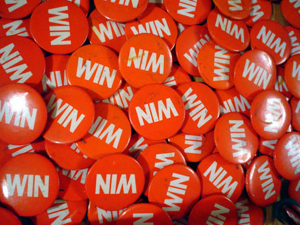 (NOTE: Check out the other posts in The Secrets of Nim series.)
(NOTE: Check out the other posts in The Secrets of Nim series.)
In the very first Secrets of Nim post, I discussed a variation of the game where you start at zero, and add objects up to certain total, such as 21. What happens if, instead of adding, you were to multiply?
Just as with previous versions, we need to start by laying down a few ground rules.
First, what's the goal? Since we're going to be multiplying, and numbers tend to get large quick, we'll need a number that's large enough to keep the game interesting, but small enough to keep from dragging the game on for too long. Those who remember Scam School's first Pi Day Magic Trick will understand why 1 million makes a good goal when multiplying numbers.
Since you can't really use objects, as in many other versions of Nim, the best thing to do is use a calculator. Obviously, multiplying by 0 is out, since you can't get out of that. Also, multiplying by 1 can't be allowed, for the same reasons you can't add 0 in other versions of Nim. So, the only numbers you're allowed to multiply by in this game are 2 through 9.
We'll play this as a standard Nim version, in which the first person whose multiplication results in a product of 1 million or more. As with all versions, two people will take turns.
Yes, because this is Nim, there's a definite winning strategy. So the major questions are: 1) What is the winning strategy? 2) Should you go first or second? And 3) How do you even go about determining a strategy?
Based on what you know about previous versions of Nim, see if you can work out a strategy. Once you think you've got an answer, check out Presh Talwalkar's post, Monday Puzzle: Alice and Bob race to 1 million. Pay special attention to the logic behind finding the winnable and losable ranges.
Once you understand which number ranges are safe and which ones are not, you'll realize that there's a problem. It would be nice if there were a simple pattern to the ranges, such as being 2-9, 20-90, 200-900, and so on, but that's not the case.
Because of this, you'll have to memorize the numbers. To simplify the task before starting, only memorize the winnable ranges. I recommend using the Peg/Major System to memorize the needed numbers. You can learn it via the videos on this playlist, as well as more detailed help here under Major system (“Peg” System). You can also find great tools to help generate mnemonics for the needed numbers here.
For example, when trying to remember the range 343 to 3086, you might use Rememberg to get a mnemonic for 343 such as "homeroom" or even "Sam Raimi". You then need a mnemonic for 3086. Rememberg came up with novelist Sam Savage, and pinfruit came up with "mass fudge". Of course, they both offer many more choices of mnemonics, so find something that suits you.
Once you've got your mnemonics, simply link them together to identify the range. For example, you might picture Sam Raimi diving into "mass fudge" (a large amount of fudge?). Then move on to the other ranges.
When you know the ranges by heart, you're ready to play. If you want to try practcing on your own, you could simulate another person choosing numbers with help from random.org. Naturally, it won't be an intelligent opponent, but this means you'll be better prepared for unexpected plays in the real world.
0
The Secrets of Nim (Multiplicative Nim)
Published on Thursday, October 27, 2011 in fun, math, memory, nim, videos
Related Posts
Subscribe to:
Post Comments (Atom)




No Response to "The Secrets of Nim (Multiplicative Nim)"
Post a Comment